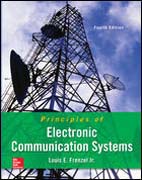
Principles of Electronic Communication Systems 4th edition provides the most up-to-date survey available for students taking a first course in electronic communications. Requiring only basic algebra and trigonometry, the new edition is notable for its readability, learning features and numerous full-color photos and illustrations. A systems approach is used to cover state-of-the-art communications technologies, to best reflect current industry practice. This edition contains greatly expanded and updated material on the Internet, cell phones, and wireless technologies. Practical skills like testing and troubleshooting are integrated throughout. A brand-new Laboratory & Activities Manual provides both hands-on experiments and a variety of other activities, reflecting the variety of skills now needed by technicians. A new Online Learning Center web site is available, with a wealth of learning resources for students. Table of contents PRINCIPLES OF ELECTRONIC COMMMUNICATIONS SYSTEMS4th EditionPrefaceChapter 1 Introduction to Electronic Communication1-1 The Significance of Human Communications1-2 Communication Systems1-3 Types of Electronic Communication1-4 Modulation and Multiplexing1-5 The Electromagnetic Spectrum1-6 Bandwidth1-7 A Survey of Communication Applications1-8 Careers in the Communications IndustryChapter 2 The Fundamentals of Electronics: A Review2-1 Gain, Attenuation and Decibels2-2 Tuned Circuits2-3 Filters2-4 Fourier TheoryChapter 3 Amplitude Modulation Fundamentals3-1 AM Concepts3-2 Modulation Index and Percentage of Modulation3-3 Sidebands and The Frequency Domain3-4 AM Power3-5 Single-Sideband Modulation3-6 Classification of Radio EmissionsChapter 4 Amplitude Modulator and Demodulator Circuits4-1 Basic Principles of Amplitude Modulation4-2 Amplitude Modulators4-3 Amplitude Demodulators4-4 Balanced Modulators4-5 SSB CircuitsChapter 5 Fundamentals of Frequency Modulation5-1 Basic Principles of Frequency Modulation5-2 Principles of Phase Modulation5-3 Modulation Index and Sidebands5-4 Noise Suppression Effects of FM5-5 Frequency Modulation versus Amplitude ModulationChapter 6 FM Circuits6-1 Frequency Modulators6-2 Phase Modulators6-3 Frequency DemodulatorsChapter 7 Digital Communications Techniques 7-1 Digital Transmission of Data7-2 Data Converters7-3 Parallel and Serial Transmission7-4 Pulse Code Modulation7-5 Pulse Modulation7-6 Digital Signal ProcessingChapter 8 Radio Transmitters8-1 Transmitter Fundamentals8-2 Carrier Generators8-3 Power Amplifiers8-4 Impedance Matching Networks8-5 Typical Transmitter CircuitsChapter 9 Communications Receivers9-1 Basic Principles of Signal Reproduction9-2 Superheterodyne Receivers9-3 Frequency Conversion9-4 Intermediate Frequency and Images9-5 Noise9-6 Typical Receiver Circuits9-7 Receivers and TransmittersChapter 10 Multiplexing and Demultiplexing10-1 Multiplexing Principles10-2 Frequency Division Multiplexing10-3 Time Division Multiplexing10-3 Pulse Code Modulation10-4 DuplexingChapter 11 Data Transmission Techniques11-1 Digital Codes11-2 Principles of Digital Transmission11-3 Transmission Efficiency11-4 Basic Modem Concepts11-5 Wideband Modulation11-6 Advanced Modem Technology11-7 Error Detection and Correction11-8 ProtocolsChapter 12 Introduction to Networking and Local Area Networks12-1 Network Fundamentals12-2 LAN Hardware12-3 Ethernet LANs12-4 Token Ring LANChapter 13 Transmission Lines13-1 Transmission Line Basics13-2 Standing Waves13-3 Transmission Lines as Circuit Elements13-4 The Smith ChartChapter 14 Antennas and Wave Propagation14-1 Antenna Fundamentals14-2 Common Antenna Types14-3 Radio Wave PropagationChapter 15 Internet Technologies15-1 Internet Applications15-2 Internet Transmission Systems15-3 Storage Area Networks15-4 Internet SecurityChapter 16 Microwave Communications16-1 Microwave Concepts16-2 Microwave Transistor Amplifiers16-3 Waveguides and Cavity Resonators16-4 Microwave Semiconductor Diodes16-5 Microwave Tubes16-6 Microwave Antennas16-7 Microwave ApplicationsChapter 17 Satellite Communications17-1 Satellite Orbits17-2 Satellite Communications Systems17-3 Satellite Subsystems17-4 Ground Stations17-5 Satellite ApplicationsChapter 18 Telecommunication Systems18-1 Telephones18-2 The Telephone System18-3 Facsimile18-4 Paging Systems18-5 Integrated Services Digital Network18-6 Internet TelephonyChapter 19 Optical Communication19-1 Optical Principles 19-2 Optical Communication System19-3 Fiber Optic Cables19-4 Optical Transmitters and Receivers19-5 Wavelength Division Multiplexing19-6 Passive Optical NetworksChapter 20 Cell Phone Technologies20-1 Cellular Telephone Systems20-2 The Advanced Mobile Telephone System20-3 Digital Cell Phone SystemsChapter 21 Wireless Technologies21-1 Wireless LANs21-2 PANs and Bluetooth21-3 ZigBee and Mesh Wireless Networks21-4 WiMAX and Wireless Metropolitan Area Networks21-5 Infrared Wireless21-6 Radio Frequency Identification21-7 Ultra Wideband WirelessChapter 22 Communication Tests and Measurements22-1 Communications Test Equipment22-2 Common Communication Tests22-3 Troubleshooting Techniques22-4 Electromagnetic Interference TestingAppendixGlossaryIndex
- ISBN: 9780073373850
- Editorial: McGRAW HILL COMPANY
- Encuadernacion: Rústica
- Páginas: 960
- Fecha Publicación: 09/02/2015
- Nº Volúmenes: 1
- Idioma:
